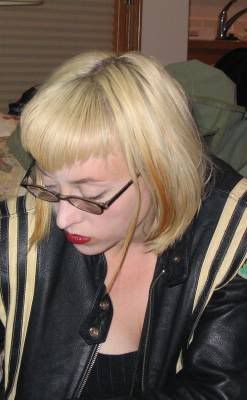Phillip Thurtle, (the last time you will probably see me use his last name), can take pleasure in knowing at least one person actually listened when he said “someone should write that down, that was good!” – someone did, and it was good, if obscure out of context, and has now been immortalized on the glorious internet as the title of my first “serious” post. After my original, and if I do say, quite charming, post, I’ve hit a bit of writer’s block. There is, after all, serious pressure on my part to live up to the clever wit I demonstrated. Then again, this is what has kept me from writing a few papers that are at this point well overdue – the basic fear (or knowledge, take your pick) that I can’t top something, be it myself or expectation, and so why bother.
That insecurity out of the way, let’s get started on 370. I’ve spent most of today reading the first few chapters of David Harvey’s The Condition of Postmodernity, and will have two posts following this (not immediately, but at some point) solely on that subject. This post, however, will find us backtracking to last Wednesday and the first day of class.
Phillip spent the first class introducing us to his method of teaching (energic, especially with the consumption of an energy bar prior to class), the idea of reading as an extreme sport (a-ha, you note the homage now), and an introduction to the idea of postmodernity through definition of modernity and the odd use of Jeff Koons’ porcelain, gold-gilt, life-sized sculpture of Michael Jackson and Bubbles, which resides in San Francisco’s Museum of Modern Art. Phillip used this gold giver-of-nightmares to start off a discussion on modernity and postmodernity because if we think that this is a serious, stern piece of art, it’s rather scary and something of an abomination. But if we tilt our head to the side and take a step back, perhaps unfocusing our eyes a little in the process, the sculpture turns into an ironic commentary on both Michael Jackson and our culture as a whole. It goes from being a looming horror to something accessible through irony and humour, which could be a direct corrollary to how post-modernity sees itself in relation to modernity. Using a medium traditionally relegated to a grandmother’s collection of kitsch simply emphasizes the surface nature of the piece; there is no depth, nothing substantial. It’s merely a reproduction, although a reproduction of what is a valid question to ask.
The slideshow moved on to pictures by photographer Cindy Sherman, who’s probably best known for her artistic, photographic reproductions of movie stills. She accurately recreates a still scene from a movie, and then places herself in the role, pose, position of the star she’s mimicing. It’s another take on the concept of art and reproduction, and she goes from glamour-puss to pin-up to images that are truly not work safe (so clickylinky at your own risk).
Two other artists were also shown in the slideshow, and I wanted to mention (of all of them) Mark Tansey for his truly amazing art that’s stayed with me since class. Unfortunately, I couldn’t find either of the pictures shown in class, which is a pity as they were really fascinating. The one that’s been somewhat glued to my mental projection screen was one of a man walking into, being absorbed by, a blue-black wall of text; all that’s left is a bit of calf and foot. Phillip rather accurately used this image to describe what going into any class heavy on literary theory and historicism is like – you’re being eaten alive by a conversation that was started fifteen years and innumerable beers before you, and you’ve to catch up and make your contribution in a short span of weeks. It’s what 390 felt like over the summer, as a matter of fact… anyhow, it was a great image. Alas, I couldn’t find it. But I did find this, Derrida Queries De Man, which I find almost as engrossing, and quite a bit funnier.
I hadn’t meant this to turn into an art criticism and explanation post; as a matter of fact, I had wanted to talk a bit about some notes I took on nature being considered “the other,” and how by creating that other the whole of the Enlightenment can be defined. By giving a singular, umbrella name to a gloriously broad and diverse concept, Enlightenment thinkers anthropomorphized and created a foe for Man; Man was defined as against this other of Nature. Which, I think, is an interesting idea, although I would be pressed to argue that the anthropomorphization of Nature existed long before the Enlightenment; we can see it in many aboriginal religions. The difference with the Enlightenment thinkers was their desire to place Man above and in opposition to Nature; she was a force to be tamed (and I don’t believe it coincidence that Nature is portrayed as a she). But, and partly related to this last sidenote, I think it important to remember that the Enlightenment thinkers were attempting to step out of and move past the shadow of religion, and religion very much held that man dominated nature. I think it was less so in so-called premodern times, especially compared to the fundamentalist sects of today, but the idea existed. The Enlightenment thinkers, those who existed in the era we begin defining as modern (largely by their works), were looking for a way to justify their position in the “natural order” without relying on theology to do so. There was no reason to discard the concept of man being separate from nature as a controlling factor in religion, merely to remove religion from holding the reigns of control. So while Man might be a concept formed against Nature, I do not believe Nature was a concept formed against Man.

